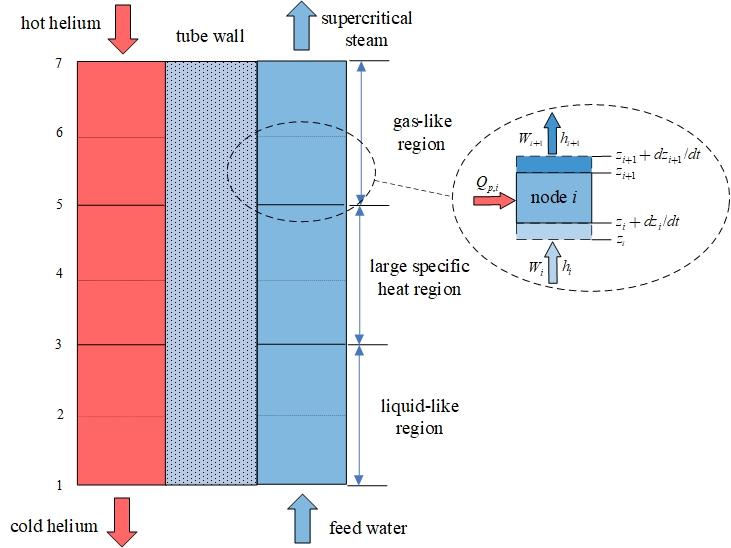The advanced modular high-temperature gas-cooled reactor (MHTGR) nuclear power plant utilizes a helical-coiled once-through steam generator (OTSG) to cool the nuclear reactor and supply steam to the turbine for electricity generation. In the heat transfer assemblies of the OTSG, the primary helium enters the shell side and transfers heat to the secondary water flowing inside the helical tube bundle through the metal tube wall. By increasing the secondary pressure up to supercritical conditions, supercritical OTSG can contribute to promising advantages of enhanced power generation and higher thermal efficiency of MHTGR [1].
Compared to the commercially operated subcritical OTSG, the novel supercritical OTSG is operated above the thermodynamic critical point of water (373.95 ℃, 22.064 MPa). Near the pseudocritical point of water, rapid variations in thermophysical properties including the significant drops in density, molecular viscosity and thermal conductivity, as well as the sharp peak in specific heat, can be observed [2]. These characteristics can strongly influence the flow resistance and heat transfer of the secondary water and result in changes in convective heat transfer performance of the OTSG. In addition, a secondary flow caused by the centrifugal force will occur on the cross-section of helical tube, leading to heat transfer enhancement.
To investigate the thermal hydraulic characteristics of the helical-coiled supercritical OTSG, this study develops a dynamic lumped parameter model with movable boundaries. As illustrated in Figure 1, the supercritical OTSG is handled with single tube concept and is divided into three heat transfer regions with a total of seven nodes. The specific heat of water reaches a peak near its pseudocritical point and the region with a specific heat greater than 8.4 kJ/(kg∙K) is typically considered as the large specific heat region, while regions with lower or higher temperatures are treated as the liquid-like and gas-like regions, respectively. The three-region movable-boundary OTSG model is formulated based on the fundamental conservation of mass, energy and momentum. The thermophysical properties of helium and water are calculated by Safety Standard KTA 3102 [3] and basic equations of IAPWS-IF97 [4]. The empirical correlations for pressure drop and heat transfer of the fluids are summarized from experimental data and discussed in detail.
Numerical simulation plays a crucial role in the field of nuclear engineering for investigating fluid dynamics and heat transfer phenomena. Extensive research is conducted using a variety of simulation techniques ranging from commercial software such as RELAP and ANSYS, to some recently developed toolboxes on MATLAB/Simulink platform [5]. The OTSG model in this study can be mathematically formulated as a set of differential algebraic equations (DAEs) in the Hessenberg form. The simultaneous approach is introduced to efficiently solve the dynamic model and facilitate control applications [6]. In the simultaneous simulation, both the state and control profiles in the OTSG model are temporally discretized using the orthogonal collocation on finite elements method, and the resulting algebraic equations can be solved by existing nonlinear programming solvers.
The model accuracy is validated by numerical simulations of the steady operating point and dynamic step response under full thermal power level. The model predictions agree well with the experimental design data, both the fluid dynamics and heat transfer characteristics are well predicted.
References:
[1] Z. Zhang, P. Ye, X. T. Yang, H. M. Ju, S. Y. Jiang, and J. Y. Tu, “Supercritical steam generator design and thermal analysis based on HTR-PM,” Ann Nucl Energy, vol. 132, pp. 311–321, Oct. 2019.
[2] I. L. Pioro, “Current status of research on heat transfer in forced convection of fluids at supercritical pressures,” Nuclear Engineering and Design, vol. 354, Dec. 2019.
[3] Federal Republic of Germany, Reactor Core Design of High-Temperature Gas-Cooled Reactor Part 1: Calculation of the Material Properties of Helium, Nuclear Safety Standards Commission (KTA), Federal Republic of Germany, Berlin, Germany, 1978, KTA 3102.1.
[4] W. Wagner and H.-J. Kretzschmar, International Steam Tables. Springer Berlin Heidelberg, 2008.
[5] Z. Dong, Y. Pan, Z. Zhang, Y. Dong, and X. Huang, “Dynamical modeling and simulation of the six-modular high temperature gas-cooled reactor plant HTR-PM600,” Energy, vol. 155, pp. 971–991, Jul. 2018.
[6] D. R. Herber and J. T. Allison, “Nested and simultaneous solution strategies for general combined plant and control design problems,” Journal of Mechanical Design, vol. 141, no. 1, Jan. 2019.


